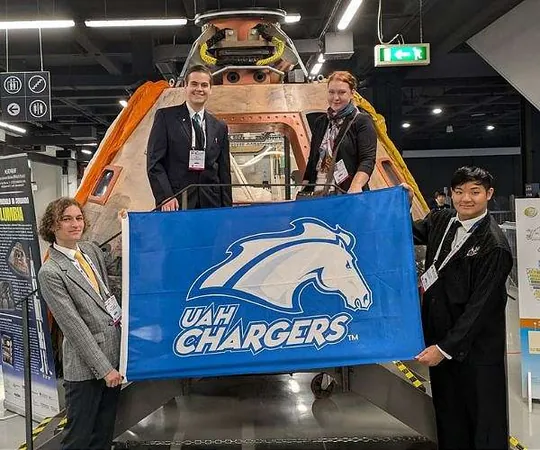
UAH Electric Propulsion Club Unveils Groundbreaking Ion Thruster at International Congress in Italy!
2025-01-04
Author: Daniel
UAH Electric Propulsion Club Unveils Groundbreaking Ion Thruster at International Congress in Italy!
Huntsville, AL — In a thrilling development for the aerospace community, the Electric Propulsion Club (EPC) at the University of Alabama in Huntsville (UAH) showcased their revolutionary experimental ion thruster, named STARGATE, at the prestigious 75th International Astronautical Congress (IAC) in Milan, Italy. This innovative project is spearheaded by a group of ambitious UAH undergraduates who are pioneering research in electric propulsion (EP) and plasma physics.
With the rise of small satellites orbiting Earth, there is an urgent need for efficient, low-power electric propulsion systems. These systems enable essential functions like autonomous station keeping, collision avoidance, and orbit modification, which are critical for the operational viability of modern satellite systems.
The IAC attracted over 11,000 participants from more than 120 countries, including directors from 60 national space agencies, making it a monumental networking opportunity for young innovators like the EPC team. Attendees included prominent figures such as NASA's Administrator and Deputy Administrator, alongside representatives from the United Nations Office of Outer Space Affairs.
The team, led by UAH Aerospace Engineering junior Claude Blue, also included mechanical engineer Noa Milivojevic, and physics and engineering sophomores Dmitri Tsahelnik and Ella Hazle. Together, they are developing a unique gridded ion thruster that employs corona discharge for plasma generation, marking a significant departure from traditional ionization techniques. This pioneering technology is currently under review for patenting by the UAH Office of Technology Commercialization.
"Ion thrusters are poised to revolutionize how we propel spacecraft," Blue stated. "By utilizing innovative methods for plasma production, STARGATE could provide a superior propulsion solution for small satellites in low Earth and geostationary orbits, enhancing their operational capabilities dramatically."
The STARGATE system creates thrust by ionizing a neutral gas, producing positive ions that are then accelerated using high-voltage electric fields in a gridded configuration. This process allows spacecraft to achieve high specific impulse and efficient thrust over extended periods, a crucial factor for long-duration missions.
At the congress, the team not only presented their research but also forged valuable connections that could lead to future collaborations. "We gained insights into the latest advancements in space technology and made potential partnerships that can help advance our project further," Blue recounted.
EPC's journey to Italy was made possible after winning the 2023 Von Braun Symposium Student Poster Contest, with additional financing students enabling the entire club to attend. The group received support from several notable sponsors, including the Alabama Space Grant Consortium and various UAH faculty members, demonstrating community backing for young innovators in space research.
Reflecting on their experience, Blue commented, "This trip has been a powerful motivation for our club. We witnessed the unveiling of cutting-edge technologies, including VAST Space's HAVEN 2 and the AXIOM PRADA spacesuit. Understanding the current space economy and industry priorities has empowered us to think big about the future of our project."
As the EPC continues to develop the STARGATE thruster, their pioneering work epitomizes the innovative spirit of the next generation of aerospace engineers. Keep an eye on UAH—these ambitious students may soon play a pivotal role in shaping the future of space exploration!


 Brasil (PT)
Brasil (PT)
 Canada (EN)
Canada (EN)
 Chile (ES)
Chile (ES)
 Česko (CS)
Česko (CS)
 대한민국 (KO)
대한민국 (KO)
 España (ES)
España (ES)
 France (FR)
France (FR)
 Hong Kong (EN)
Hong Kong (EN)
 Italia (IT)
Italia (IT)
 日本 (JA)
日本 (JA)
 Magyarország (HU)
Magyarország (HU)
 Norge (NO)
Norge (NO)
 Polska (PL)
Polska (PL)
 Schweiz (DE)
Schweiz (DE)
 Singapore (EN)
Singapore (EN)
 Sverige (SV)
Sverige (SV)
 Suomi (FI)
Suomi (FI)
 Türkiye (TR)
Türkiye (TR)
 الإمارات العربية المتحدة (AR)
الإمارات العربية المتحدة (AR)